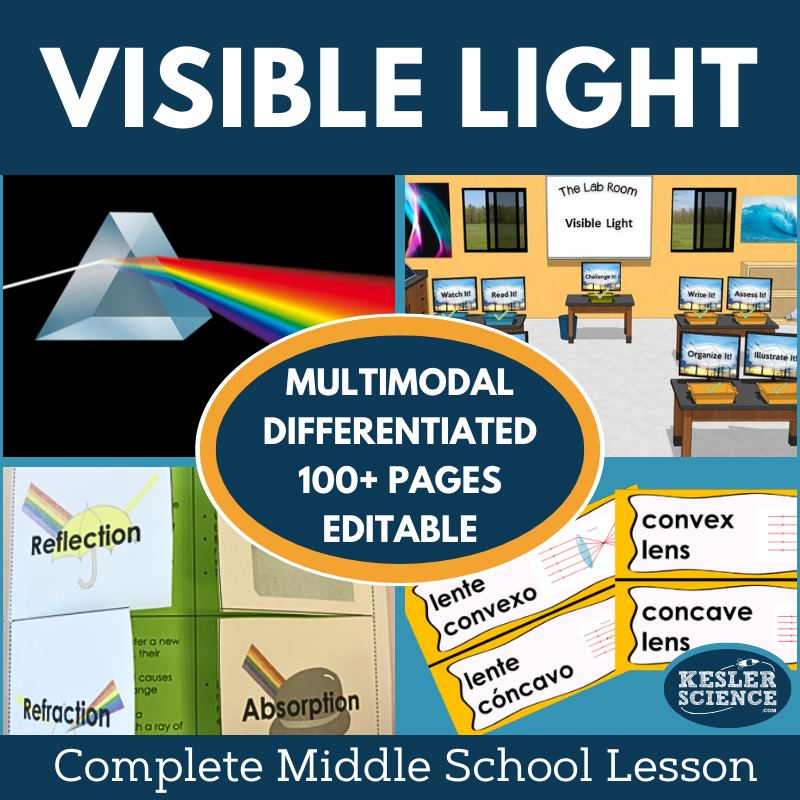
Visible Light Complete Lesson Plan - MS
This complete unit provides everything middle school teachers need to teach the properties and behavior of visible light. Students explore where visible light falls on the electromagnetic spectrum, how light interacts with materials, how color is produced, and how brightness is determined. The resource includes editable presentations, worksheets, student-choice projects, a differentiated station lab, and assessments. Designed for multiday use with minimal prep, it emphasizes differentiated, student-led learning so teachers can focus on guiding student mastery.
Essential Questions for Students
-
Where does visible light fall on the electromagnetic spectrum?
-
How does an object’s material and light’s frequency (color) affect reflection, absorption, or transmission?
-
How does the frequency of a light wave determine its color?
-
How do primary colors of light produce secondary and complementary colors?
-
How does the amplitude of a light wave determine brightness?
Key Features
-
Differentiated resources to support all learners
-
Multimodal learning experiences to sustain engagement
-
Flexible delivery—resources are available in both printable and digital formats
-
Editable PowerPoints for easy classroom customization
-
Spanish translations of vocabulary, a station lab reading passage, and interactive notebook pages
Instructional Framework: The 5E Model
This lesson follows the 5E instructional model—Engage, Explore, Explain, Elaborate, Evaluate—balancing inquiry, practice, and assessment.
Engage
-
Objectives and Word Wall Cards (English & Spanish)
-
Teacher file with discussion prompts, classroom activity ideas, and notes on misconceptions
Explore
-
A nine-station, student-led lab introduces visible light and its properties
Input Stations:
-
Explore It! – Hands-on demonstration or experiment
-
Read It! – Differentiated reading passages (English & Spanish) with comprehension questions
-
Research It! – Guided online activity with structured tasks
-
Watch It! – Short video with discussion prompts
Output Stations:
-
Organize It! – Printable and digital card sorts for categorization
-
Write It! – Open-ended written responses
-
Illustrate It! – Sketching/drawing activities to reinforce concepts
-
Assess It! – Vocabulary-in-context and mastery-based questions
Bonus Station:
-
Challenge It! – Games, puzzles, or mini-projects for enrichment or early finishers
Explain
-
Editable PowerPoints in standard and interactive versions
-
Interactive Notebook templates (digital & print, English & Spanish)
-
Guided note-taking templates
Elaborate
-
Student-choice projects on visible light to extend or apply learning
Evaluate
-
Assessments updated for STAAR 2.0, available in standard and modified versions
-
Review worksheets and discussion questions for homework, practice, or test prep
Flexible Learning Options
This lesson is designed for both in-person and virtual classrooms. The digital station lab and interactive notebook materials are fully compatible with PowerPoint and Google Slides, making them easy to integrate into blended or online learning environments.
This is a finished product; it will be updated with formatting or corrections as needed. Future improvements and new features will be sold as a separate product.
Pickup currently not available
Terms of Use
Copyright © Kesler Science, LLC. All rights reserved by the author. This product is to be used by the original downloader only. Copying for more than one teacher, classroom, department, school, or school system is prohibited. Permission is never granted to enter Kesler Science materials into any form of AI for any purpose. This product may not be distributed or displayed digitally for public view. Failure to comply is
copyright infringement and a violation of the Digital Millennium Copyright Act (DMCA). Clipart and elements found in this PDF are
copyrighted and cannot be extracted and used outside of this file without permission or license. Intended for classroom and personal use ONLY. Multiple licenses are available for purchase by departments,
schools, or school districts. Contact support@keslerscience.com for more information.



















